technical data AUDI A4 AVANT 2008 Owner's Manual
[x] Cancel search | Manufacturer: AUDI, Model Year: 2008, Model line: A4 AVANT, Model: AUDI A4 AVANT 2008Pages: 368, PDF Size: 46.19 MB
Page 201 of 368

__________________________________________________ A_ i_ r _b _a-' g=- s_ y=-- s_t _e _m ______ lfflll
PASSENGER AIR BAG OFF light
N
-M -J., a, cc
Fi g. 18 0 Sec tion fr om
t h e i nstr um ent pa nel:
P ASSE NG ER AI R BA G
OFF lig ht
The PASSENGER AIR BAG OFF light is located in the center o f the
ins trumen t panel
=> fig . 180 .
The PASSENGER AIR BAG OFF light wil l come on and stay on to te ll
you when the front Advanced Airbag on the passenger side has been turned off by the electronic control unit. Each time you turn on
the ign it ion, the
PA SS ENGER AIR BA G OFF light wi ll fl as h for a few
seconds and :
• will stay on if t he front passenger seat is not occupied,
• will stay on if there is a small child or chi ld restraint on the front
passenger seat,
• will go out if the front passenger seat is occupied by an adult as
registered by the we ight -sens ing mat.
The
PA SS ENGER AIR B AG OFF light mu st come on and stay on if the
ignition is on and
• a car bed has been instal led on the front seat, or
• a rearward -facing chi ld restraint has been installed on the front
passengerseat,or
Controls and equip ment Safety first
Vehicle operation
• a forward -facing child restraint has been instal led on the front
passenger seat, or
• the weight register ed on the front passenger seat is equa l to or
less than the combined weigh t of a typica l 1 year-old restrained in
one of the rear -facing or forward -facing infant restraints listed in
Federa l Motor Veh ic le Safe ty S tandard
208 with wh ich the Advanced
Airbag System in your vehicle was certified .
If the front passenger seat is not occupied, the front airbag will not
dep loy, and the
PA SS ENGER AIR BAG OFF light will stay on . Never
insta ll a rearward -facing child restraint on the front passenger seat,
the safest place for a child in any kind of ch ild restraint is at one of
the seating positions on the rear
seat => page 189, "Ch ild restraints
on the front sea t-some important things to know"
and => page 210,
"Chi ld Safety" .
If the PASSENGER AIR BAG OFF light comes on when one of the
condit ions listed above is met , be sure to check the light regu lar ly
to make certain that the
PA SSENGER AIR BAG OFF light stays on
cont inuously whenever the ignition is on . If the PASSENGER AIR
BAG OFF light does not appear and not stay on all the time , stop as
soon as it is safe to do so and
• reactivate the system by turning the ignition off and then turning
it on again;
• remove and reinstall the ch ild restraint. Make sure that the child
res tra int is proper ly instal led and t hat t he sa fety be lt for the front
passenger seat has been correctly routed around the child restraint
as described in the chi ld restraint manufacturer's instructions;
• make sure that the convertible locking feature on the safety belt
for the front passenger seat has been activated a nd that the safety
belt has been pulled t ight . The belt must not be loose or have loops
of slack so t hat t he sensor below t he safety belt latch on the seat can
do its job
=> page 220.
• make s ure that th ings that may inc rease the we ight of the child
and child safety seat are not being transported on the front
passenger seat;
Vehicle care Do-it-yourself service Technical data
Page 203 of 368
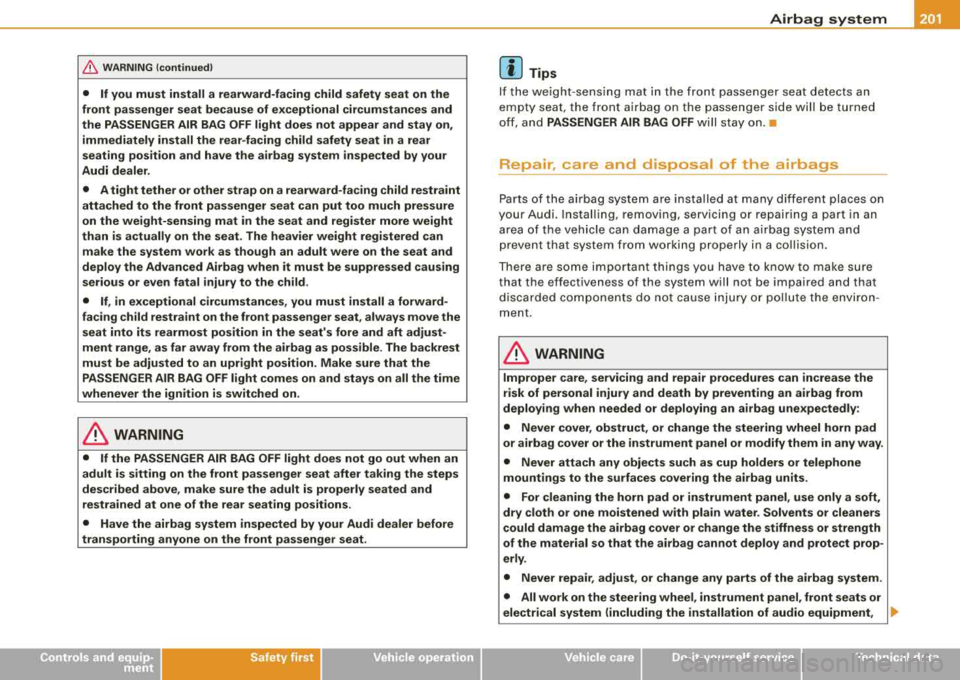
& WARNING (continued)
• If you must install a rearward-facing child safety seat on the
front passenger seat because of exceptional circumstances and
the PASSENGER AIR BAG OFF light does not appear and stay on ,
immediately install the rear -facing child safety seat in a rear
seating posit ion and have the airbag system inspected by your
Audi dealer .
• A tight tether or other strap on a rearward-facing child restraint
attached to the front passenger seat can put too much pressure
on the weight-sensing mat in the seat and register more weight
than is actually on the seat. The heavier weight registered can make the system work as though an adult were on the seat and
deploy the Advanced Airbag when it must be suppressed causing
serious or even fatal injury to the child.
• If , in exceptional circumstances , you must install a forward
facing child restraint on the front passenger seat , always move the
seat into its rearmost position in the seat 's fore and aft adjust
ment range , as far away from the airbag as possible. The backrest
must be adjusted to an upright position . Make sure that the
PASSENGER AIR BAG OFF light comes on and stays on all the time
whenever the ignition is switched on .
& WARNING
• If the PASSENGER AIR BAG OFF light does not go out when an
adult is sitting on the front passenger seat after taking the steps
described above , make sure the adult is properly seated and
restrained at one of the rear seating positions .
• Have the airbag system inspected by your Audi dealer before
transporting anyone on the front passenger seat .
Controls and equip ment Safety first
Vehicle operation
Airbag system
[ i ] Tips
If the w eig ht-sens ing ma t in th e front passe nger seat detects an
e m pty seat , the front airbag on the pa ssenge r side wil l be turned
o ff , a nd PASSENGER AIR BAG OFF will stay o n.
a
Repair, care and disposal of the airbags
Pa rts o f the airba g sy ste m are i nsta lled at many d ifferen t pl aces on
y our Audi. Instal ling, removing , se rvicing or re pairing a pa rt in an
ar ea of th e ve hicle ca n da mage a part of an airbag syst em and
prevent that system from wor king properly in a co llision.
T he re a re so me impo rtant thin gs you have to know t o make sure
that the effectiv eness of the system will not be impaired and that
di scar ded co mpon ents do not ca use inju ry o r po llut e th e env iron
m ent .
& WARNING
Improper care , servicing and repair pro cedures can increase the
risk of personal injury and death by preventing an airbag from
deploying when needed or deploying an airbag unexpectedly :
• Never cover, obstruct, or change the steering wheel horn pad
or airbag cover or the instrument panel or modify them in any way.
• Never attach any objects such as cup holders or telephone
mountings to the surfaces covering the airbag units .
• For cleaning the horn pad or instrument panel , use only a soft ,
dry cloth or one moistened with plain water . Solvents or cleaners
could damage the airbag cover or change the stiffness or strength
of the material so that the airbag cannot deploy and protect prop
erly .
• Never repair , adjust , or change any parts of the airbag system.
• All work on the steering wheel, instrument panel, front seats or
electrical system (including the installation of audio equipment ,
...,
Vehicle care Do-it-yourself service Technical data
Page 211 of 368

__________________________________________________ A_ i_ r _b _a-' g=- s_ y=-- s_t _e _m ______ lJfflll
& WARNING (continued)
expansion range of a SIDEGUARD head airbag can dangerously
interfere with its function. A deploying head airbag develops
enough force to catapult any piece of add-on component out of its
path of inflation and into the passenger compartment. An occu
pant hit by such a projectile can suffer serious injury or death
=> page 349, "Technical Modifications".
• Do not swivel the sun visors to the side if you have any objects
clipped onto them (for example
pens!. If the airbag should deploy,
you could be injured by these objects.
• Use the built-in coat hooks only for lightweight clothing. Never
leave any heavy or sharp-edged objects in the pockets that may
interfere with airbag deployment and can cause personal injury in
an accident.
• Never use hangers to hang clothing from the hooks.
• Only use factory-installed sun shades or, in the case of shades
installed after the vehicle leaves the factory, only Audi roll-up
sunscreens may be used => page 348, "Additional accessories and
parts replacement".
• Always sit in proper seating position and wear safety belts
while traveling so that the side curtain airbags can help provide protection .
• The airbag system can only be triggered once. If the airbag has
been triggered, the system must be replaced by an authorized
Audi dealer or qualified workshop.
• Always have work involving the side curtain airbag system,
removal and installation of the airbag components, or other
repairs performed by a qualified dealership. Otherwise the airbag
system may not work correctly.
• Never attempt to modify any components of the airbag system
in any way. •
Controls and equip ment Safety first
Vehicle operation Vehicle care Do-it-yourself service Technical data
Page 213 of 368

& WARNING (conti nued )
• Alw ays install r ear-facing child saf ety s eats on the r ear seat.
• If you mu st in sta ll a re arwa rd f acing child safe ty s eat on the
front pas senger seat in exc eptional cir cum stances and the
PASSENGER AIR BAG OFF light doe s not come on and stay on,
immediat ely install th e rear-fa cing child safety s eat in a rear
s e ating po sit ion and h ave the airb ag sys tem in spe cted immedi
a tel y by y our Audi dealer .
& WARNING
If, in exceptional circum stance s, you must in stall a forward -fac ing
c hild re st ra int on the fr ont p assenge r's s eat:
• Alway s make sure the forward -facing seat ha s been de signed
and cert ified by it s m anuf acturer for u se on a front se at with a
pa ssenger front and side airbag .
• Always follow the m anufacturer's instruct ions provided w ith
the child safet y seat or c arrier.
• Alway s m ov e th e passeng er sea t into it s re arm ost p osit ion in
the seat' s fore and aft adju stment range , as far away from the
a irb ag as possible before installin g the ch ild r estr aint . The b ack
rest must be adjusted to an upright po sition.
• Alway s ma ke sure th at the PASSENGER AIR BAG OFF light
come s on and stay s on all the time wheneve r the ignition i s
s wit ched on . •
Advanced front airbag system and children
Your vehicle is equipped with a dual -stage front "Advanced Airbag
System" in comp liance with United States Federal Motor Vehicle
Safety Standard ( FMVSS) 208 as applicab le at the time your vehic le
was manufactured .
Controls and equip
ment Safety first Vehicle operation
Chi
ld Sa fe ty
The Advanced Airbag system in your vehic le has been certified to
meet the " low -risk" require ments for 3 and 6 yea r- old c hild ren on
the passenger side and small adu lts on the driver side . The low risk
deployment c rite ria are intended to reduce the risk of inju ry th rough
interaction with the airbag that can occur, for example, by being too
close to the steering whee l and instrument panel when the airbag
in flates . In add it ion, the system has been cert ified to comply with
the "suppression" requirements of the Safety Standard, to turn off
the front airbag for in fants up to 12 months who are restrained on
the front passeng er seat in child restraints that are listed in the
Standard.
Even though your vehic le is equipped with an Advanced Airbag
system, all ch ildren, especially those 12 years and younger, sho uld
a lways ride in the back seat proper ly restra ined for the ir age and
size . The airbag on the passenger side makes the front seat a poten
tially dangerous p lace for a chi ld to r ide. The front seat is not the
safest p lace for a chi ld in a forward -facing child safety seat. It can be
a very dangerous place for an infant or a larger chi ld in a rearward
facing seat. •
Advanced Airbags and the weight-sensing
mat in the front seat
The Advanced A irbag System in your ve hicle detects the p resence
of an infant or chi ld in a child restraint on the front passenger seat
using the weight -sensing mat in the seat cushion and the sensor
below the safety belt latch on the front passenger seat that
measures the tension on the safety belt .
The weight -sensing mat meas ures total we ig ht of the ch ild and the
child safety seat and a chi ld blanket on the front passenger seat. The
weight o n the fr ont passenge r seat is related to the desig n of the
child restraint and its "footprint" , the size and shape of the bottom
of the child restraint as it sits on the seat. The weight of a child
restraint and its "footprint" vary for different kinds of chi ld
_..
Vehicle care Do-it-yourself service Technical data
Page 215 of 368
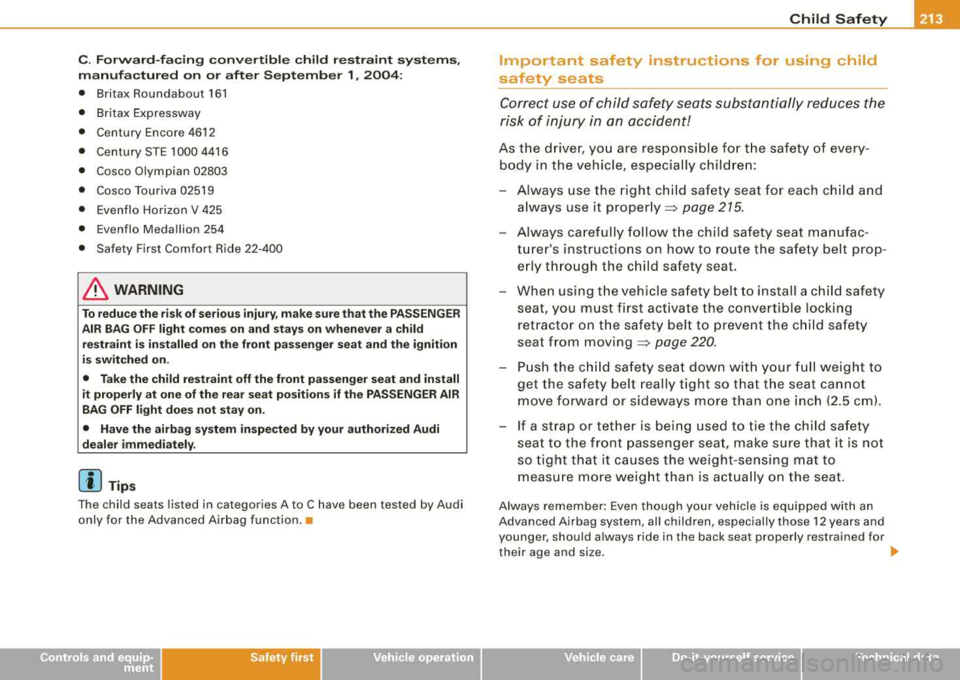
Child Safety -
---------------''------'
C. Forward-facing convertible child restraint systems,
manufactured on or after September 1, 2004:
• Britax Roundabo ut 161
• Brit ax Expressway
• Century Encor e 4612
• Century STE 1000 4416
• Cosco Olympian 02803
• Cosco Touriva 02519
• Evenflo Horizon V 425
• Evenflo M edallion 254
• Safety First Comfor t Ride 22-400
& WARNING
To reduce the risk of serious injury, make sure that the PASSENGER
AIR BAG OFF light comes on and stays on whenever a child restraint is installed on the front passenger seat and the ignition
is switched on.
• Take the child restraint off the front passenger seat and install
it properly at one of the rear seat positions if the PASSENGER AIR
BAG OFF light does not stay on.
• Have the airbag system inspected by your authorized Audi
dealer immediately.
[ i] Tips
Th e child s eats lis ted in cat egori es A to C have been tes ted by Audi
only for the Advanced Airbag function. •
Controls and equip
ment Safety first Vehicle operation
Important safety instructions for using child
safety seats
Correct use of child safety seats substantially reduces the
risk of injury in an accident!
As the driver, you are responsible for the safety of every
body in the vehicle, especially children:
- Always use the right child safety seat for each child and
always use it properly :::>
page 215.
-Always carefully follow the child safety seat manufac
turer's instructions on how to route the safety belt prop
erly through the child safety seat.
- When using the vehicle safety belt to install a child safety
seat , you must first activate the convertible locking
retractor on the safety belt to prevent the child safety
seat from
moving => page 220.
- Push the child safety seat down with your full weight to
get the safety belt really tight so that the seat cannot
move forward or sideways more than one inch (2.5 cm).
- If a strap or tether is being used to tie the child safety
seat to the front passenger seat, make sure that it is not
so tight that it causes the weight-sensing mat to
measure more weight than is actually on the seat.
Always remember: Even though your vehicle is equipped with an
Advanced Airbag system, all children, especially those 12 years and
younger, should always ride in the back seat properly restrained for
their age and size .
..,_
Vehicle care Do-it-yourself service Technical data
Page 219 of 368
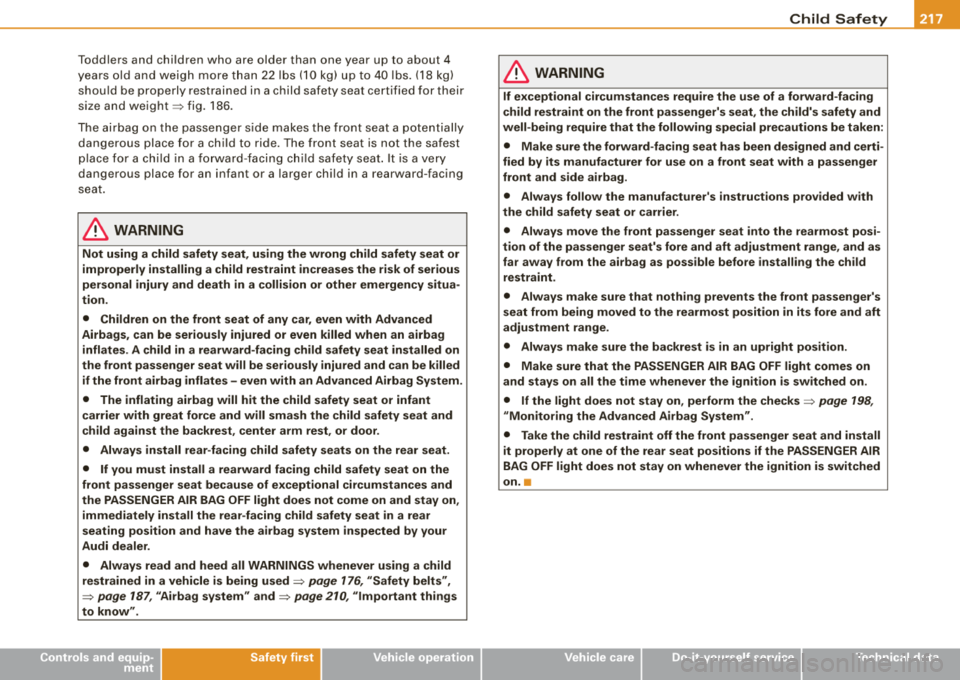
Child Safety -
---------------''------'
Toddle rs and chi ldren who ar e older than one y ear up to about 4
ye ars old and wei gh m ore th an 2 2 lbs (1 0 kg) u p to 40 lbs. (1 8 kg)
shou ld be prope rly restrained in a c hild saf ety s eat c ertifi ed for their
si ze and we igh t=> fig. 18 6.
T he a irba g on t he passe nger s id e m akes t he fr ont seat a p otentially
dangerou s place fo r a child to ride. The front seat is not the safest
pl ace fo r a c hild in a forw ard -f ac ing child safety sea t. It is a very
dangerous place for an infant o r a larger ch ild in a rearward-facing
s e at .
& WARNING
Not using a child safety seat, using the wrong child safety seat or
improperly installing a child restraint increases the risk of serious
personal injury and death in a collision or other emergency situa
tion .
• Children on the front seat of any car, even with Advanced
Airbags, can be seriously injured or even killed when an airbag inflates . A child in a rearward-facing child safety seat installed on
the front passenger seat will be seriously injured and can be killed
if the front airbag inflates - even with an Advanced Airbag System .
• The inflating airbag will hit the child safety seat or infant
carrier with great force and will smash the child safety seat and
child against the backrest, center arm rest, or door.
• Always install rear -facing child safety seats on the rear seat.
• If you must install a rearward facing child safety seat on the
front passenger seat because of exceptional circumstances and
the PASSENGER AIR BAG
OFF light does not come on and stay on ,
immediately install the rear -facing child safety seat in a rear
seating position and have the airbag system inspected by your
Audi dealer .
• Always read and heed all WARNINGS whenever using a child
restrained in a vehicle is being used => page 176, "Safety
belts" ,
=> page 187, "Airbag system " and => page 210, "Important things
to know".
Controls and equip ment Safety first
Vehicle operation
& WARNING
If exceptional circumstances require the use of a forward -facing
child restraint on the front passenger's seat , the child's safety and
well -being require that the following special precautions be taken:
• Make sure the forward -facing seat has been designed and certi
fied by its manufa cturer for use on a front seat with a passenger
front and side airbag.
• Always follow the manufacturer's instructions provided with
the child safety seat or carrier.
• Always move the front passenger seat into the rearmost posi
tion of the passenger seat's fore and aft adjustment range , and as
far away from the airbag as possible before installing the child
restraint.
• Always make sure that nothing prevents the front passenger's
seat from being moved to the rearmost position in its fore and aft
adjustment range .
• Always make sure the backrest is in an upright position .
• Make sure that the PASSENGER AIR BAG
OFF light comes on
and stays on all the time whenever the ignition is switched on.
• If the light does not stay on , perform the
checks => page 198,
" Monitoring the Advanced Airbag System ".
• Take the child restraint off the front passenger seat and install
it properly at one of the rear seat positions if the PASSENGER AIR
BAG
OFF light does not stay on whenever the ignition is switched
on .•
Vehicle care Do-it-yourself service Technical data
Page 223 of 368
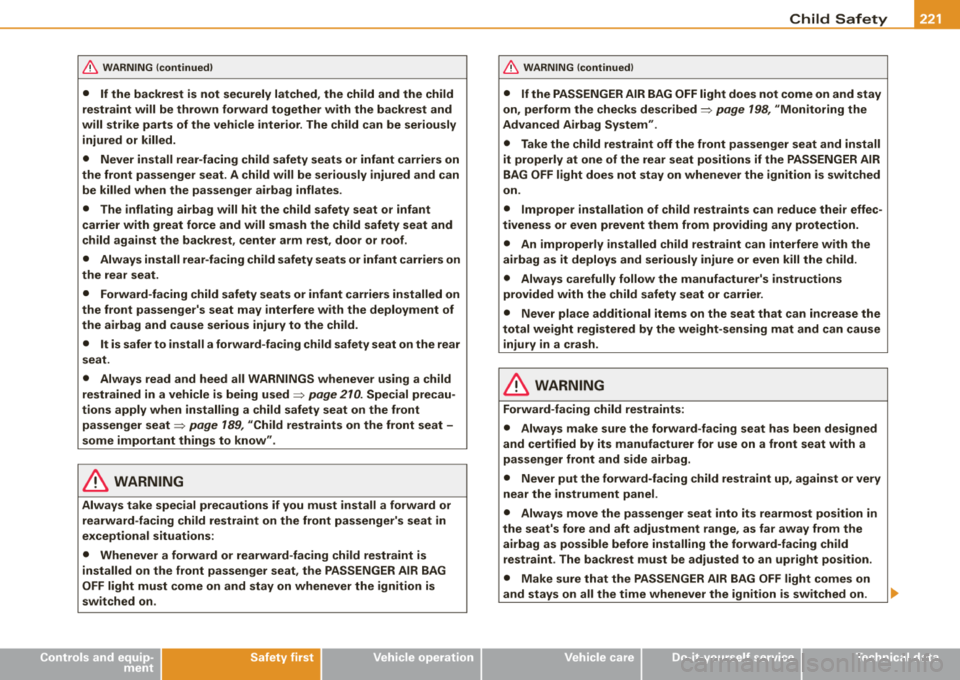
& WARNING (continued)
• If the backrest is not securely latched, the child and the child
restraint will be thrown forward together with the backrest and
will strike parts of the vehicle interior . The child can be seriously
injured or killed.
• Never install rear-facing child safety seats or infant carriers on
the front passenger seat. A child will be seriously injured and can be killed when the passenger airbag inflates .
• The inflating airbag will hit the child safety seat or infant
carrier with great force and will smash the child safety seat and
child against the backrest, center arm rest, door or roof.
• Always install rear-facing child safety seats or infant carriers on
the rear seat.
• Forward-facing child safety seats or infant carriers installed on
the front passenger's seat may interfere with the deployment of
the airbag and cause serious injury to the child.
• It is safer to install a forward-facing child safety seat on the rear
seat.
• Always read and heed all WARNINGS whenever using a child
restrained in a vehicle is being used
=> page 210. Special precau
tions apply when installing a child safety seat on the front
passenger
seat => page 189, "Child restraints on the front seat -
some important things to know".
& WARNING
Always take special precautions if you must install a forward or
rearward -facing child restraint on the front passenger's seat in
exceptional situations :
• Whenever a forward or rearward-facing child restraint is
installed on the front passenger seat, the PASSENGER AIR BAG
OFF light must come on and stay on whenever the ignition is
switched on.
Controls and equip ment Safety first
Vehicle operation
Child Safety
& WARNING (continued)
• If the PASSENGER AIR BAG OFF light does not come on and stay
on, perform the checks described
=> page 198, "Monitoring the
Advanced Airbag System" .
• Take the child restraint off the front passenger seat and install
it properly at one of the rear seat positions if the PASSENGER AIR
BAG OFF light does not stay on whenever the ignition is switched
on .
• Improper installation of child restraints can reduce their effec
tiveness or even prevent them from providing any protection.
• An improperly installed child restraint can interfere with the
airbag as it deploys and seriously injure or even kill the child.
• Always carefully follow the manufacturer's instructions
provided with the child safety seat or carrier.
• Never place additional items on the seat that can increase the
total weight registered by the weight -sensing mat and can cause
injury in a crash.
& WARNING
Forward-facing child restraints:
• Always make sure the forward-facing seat has been designed
and certified by its manufacturer for use on a front seat with a
passenger front and side airbag.
• Never put the forward-facing child restraint up, against or very
near the instrument panel .
• Always move the passenger seat into its rearmost position in
the seat's fore and aft adjustment range, as far away from the airbag as possible before installing the forward-facing child
restraint. The backrest must be adjusted to an upright position.
• Make sure that the PASSENGER AIR BAG OFF light comes on
and stays on all the time whenever the ignition is switched on. ...
Vehicle care Do-it-yourself service Technical data
Page 225 of 368
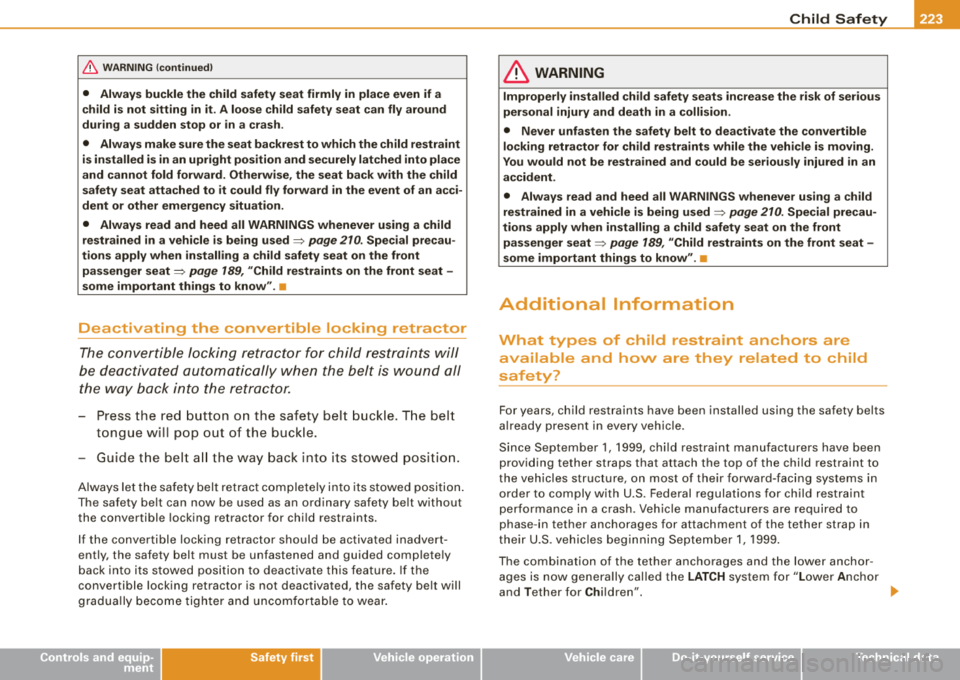
____________________________________________ C_ h_ i_ ld _ S_a_ f_e _t .:..Y _ .... 911
& WARNING (continued)
• Always buckle the child safety seat firmly in place even if a
child is not sitting in it. A loose child safety seat can fly around
during a sudden stop or in a crash.
• Always make sure the seat backrest to which the child restraint
is installed is in an upright position and securely latched into place
and cannot fold forward. Otherwise, the seat back with the child
safety seat attached to it could fly forward in the event of an acci
dent or other emergency situation.
• Always read and heed all WARNINGS whenever using a child
restrained in a vehicle is being used
=> page 210. Special precau
tions apply when installing a child safety seat on the front
passenger
seat=> page 189, "Child restraints on the front seat -
some important things to know" .•
Deactivating the convertible locking retractor
The convertible locking retractor for child restraints will
be deactivated automatically when the belt is wound all
the way back into the retractor.
- Press the red button on the safety belt buckle. The belt
tongue will pop out of the buckle.
- Guide the belt all the way back into its stowed position.
Always let the safety belt retract completely into its stowed position.
The safety belt can now be used as an ordinary safety belt without
the convertible locking retractor for child restraints.
If the convertible locking retractor should be activated inadvert
ently, the safety belt must be unfastened and guided completely
back into its stowed position to deactivate this feature. If the
convertible locking retractor is not deactivated, the safety belt will
gradually become tighter and uncomfortable to wear.
Controls and equip ment Safety first Vehicle operation
LJ}. WARNING
Improperly installed
child safety seats increase the risk of serious
personal injury and death in a collision.
• Never unfasten the safety belt to deactivate the convertible
locking retractor for child restraints while the vehicle is moving.
You would not be restrained and could be seriously injured in an
accident.
• Always read and heed all WARNINGS whenever using a child
restrained in a vehicle is being used
=> page 210. Special precau
tions apply when installing a child safety seat on the front
passenger
seat => page 189, "Child restraints on the front seat -
some important things to know" .•
Additional Information
What types of child restraint anchors are
available and hovv are they related to child
safety?
For years, child restraints have been installed using the safety belts
already present in every vehicle.
Since September 1, 1999, child restraint manufacturers have been
providing tether straps that attach the top of the child restraint to
the vehicles structure, on most of their forward-facing systems in order to comply with U.S. Federal regulations for child restraint
performance in a crash. Vehicle manufacturers are required to
phase -in tether anchorages for attachment of the tether strap in
their U.S. vehicles beginning September 1, 1999.
The combination of the tether anchorages and the lower anchor ages is now generally called the LATCH system for "Lower Anchor
and Tether for Children".
.,._
Vehicle care Do-it-yourself service Technical data
Page 227 of 368
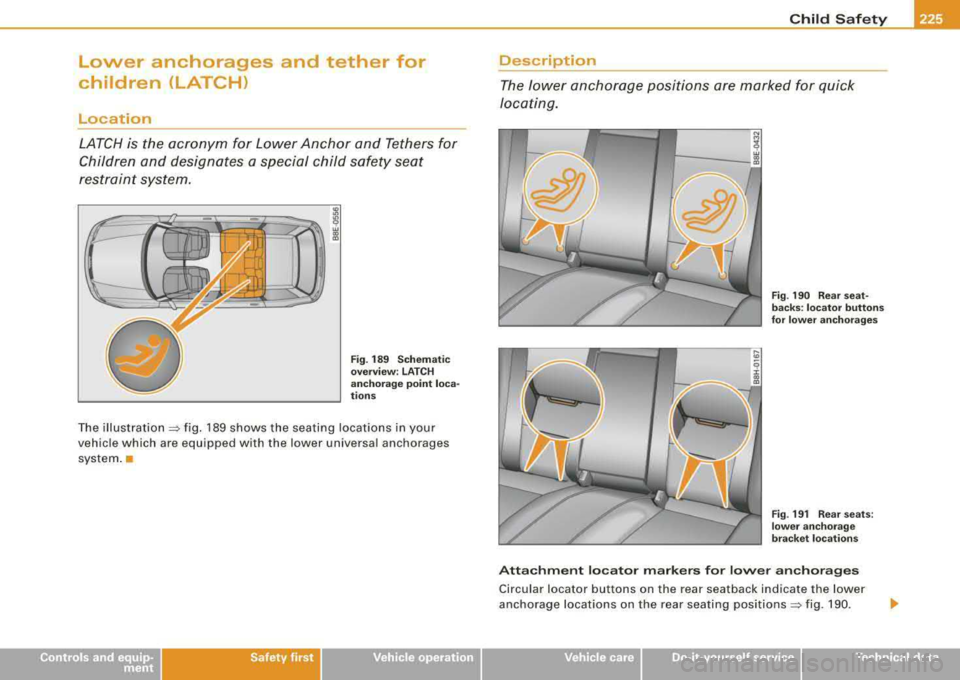
Lower anchorages and tether for
children (LATCH)
Location
LATCH is the acronym for Lower Anchor and Tethers for
Children and designates a special child safety seat
restraint system.
Fig . 189 Schematic
overview : LATCH
anchorage point loca
tions
The illustration ~ fig. 189 shows the seating locations in your
vehicle which are equipped with the lower universal anchorages
system .•
Safety first
Child Safety
Description
The lower anchorage positions are marked for quick
locating.
ij
w r-----:ll
Fig . 190 Rear seat
backs: locator buttons
for lower anchorages
Fig . 191 Rear seats:
lower anchorage
bracket locations
Attachment locator markers for lower anchorages
Circular locator buttons on the rear seatback indicate the lower
anchorage locations on the rear seating
positions~ fig. 190.
Technical data
Page 229 of 368
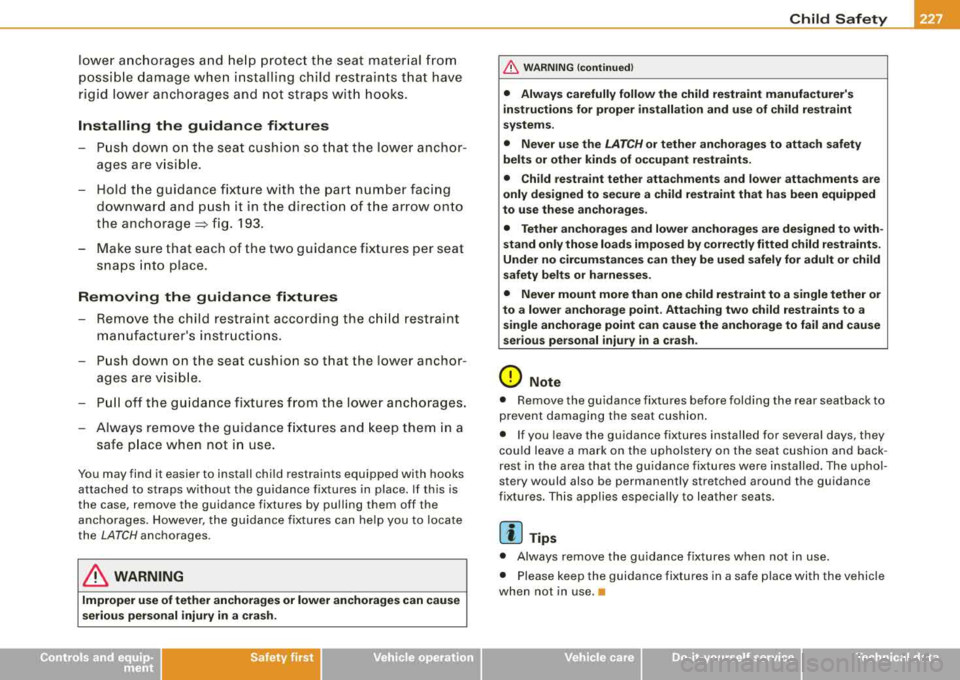
Child Safety -
---------------''------'
lower anchorages and help protect the seat material from
possible damage when installing child restraints that have
rigid lower anchorages and not straps with hooks.
Installing the guidance fixtures
- Push down on the seat cushion so that the lower anchor
ages are visible.
- Hold the guidance fixture with the part number facing downward and push it in the direction of the arrow onto
the
anchorage => fig. 193.
- Make sure that each of the two guidance fixtures per seat snaps into place.
Removing the guidance fixtures
- Remove the child restraint according the child restraint
manufacturer's instructions.
- Push down on the seat cushion so that the lower anchor
ages are visible.
- Pull off the guidance fixtures from the lower anchorages.
- Always remove the guidance fixtures and keep them in a
safe place when not in use.
You may find it easier to install child restraints equipped with hooks
attached to straps without the guidance fixtures in place. If this is
the case, remove the guidance fixtures by pulling them off the
anchorages. However, the guidance fixtures can help you to locate
the
LATCH anchorages.
& WARNING
Improper use of tether anchorages or lower anchorages can cause
serious personal injury in a crash.
Controls and equip ment Safety first Vehicle operation
& WARNING
(continued)
• Always carefully follow the child restraint manufacturer's
instructions for proper installation and use of child restraint
systems.
• Never use the
LATCH or tether anchorages to attach safety
belts or other kinds of occupant restraints.
• Child restraint tether attachments and lower attachments are
only designed to secure a child restraint that has been equipped
to use these anchorages.
• Tether anchorages and lower anchorages are designed to with
stand only those loads imposed by correctly fitted child restraints.
Under no circumstances can they be used safely for adult or child
safety belts or harnesses.
• Never mount more than one child restraint to a single tether or
to a lower anchorage point. Attaching two child restraints to a
single anchorage point can cause the anchorage to fail and cause
serious personal injury in a crash.
0 Note
• Remove the guidance fix tures before folding the rear seatback to
prevent damaging the seat cushion.
• If you leave the guidance fixtures ins talled for several days , they
could leave a mark on the upholstery on the seat cushion and back
rest in the area that the guidance fixtures were ins talled. The uphol
stery would also be permanently stretched around the guidance
fixtures. This applies especially to leather seats .
[ i] Tips
• Always remove the guidance fixtures when not in use.
• Please keep the guidance fixtures in a safe place with the vehicle
when not in use .•
Vehicle care Do-it-yourself service Technical data